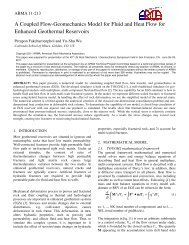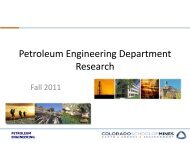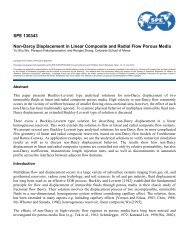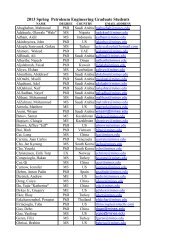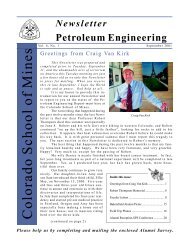SPE 146840 Pilot Testing Issues of Chemical EOR in Large ...
SPE 146840 Pilot Testing Issues of Chemical EOR in Large ...
SPE 146840 Pilot Testing Issues of Chemical EOR in Large ...
You also want an ePaper? Increase the reach of your titles
YUMPU automatically turns print PDFs into web optimized ePapers that Google loves.
<strong>SPE</strong> <strong>146840</strong> 11<strong>Pilot</strong> <strong>Test<strong>in</strong>g</strong>Injection-production multiple-well pattern pilot is very time-consum<strong>in</strong>g and expensive <strong>in</strong> large <strong>of</strong>fshore reservoirs. S<strong>in</strong>glewellmultiple might-completion design be a good way to reduce the time and cost. This <strong>in</strong>cludes dual- and triple-completionsmethods. In dual-completion mobilized oil captur<strong>in</strong>g is more difficult. In triple-completion, the mobilized oil captur<strong>in</strong>g ismore focused.ConclusionsThe numerical model<strong>in</strong>g <strong>of</strong> pilot test<strong>in</strong>g for surfactant <strong>in</strong>jection <strong>in</strong> large carbonate reservoirs led to the follow<strong>in</strong>g conclusions:1 Surfactant can mobilize rema<strong>in</strong><strong>in</strong>g oil <strong>in</strong> water-<strong>in</strong>vaded naturally fractured carbonate reservoirs to enhance oilrecovery, but the selection <strong>of</strong> the <strong>EOR</strong> chemical and the method <strong>of</strong> its delivery will determ<strong>in</strong>e the economic viability.2 For large carbonate reservoirs, especially <strong>in</strong> an <strong>of</strong>fshore environment, well-to-well pilot test<strong>in</strong>g is prohibitivebecause <strong>of</strong> oil capture and base l<strong>in</strong>e issues. However, pilot test<strong>in</strong>g <strong>in</strong> a dual- and/or triple-completion s<strong>in</strong>gle-well isplausible.3 The ma<strong>in</strong> issue with surfactant <strong>in</strong>jection <strong>in</strong> carbonate NFR is the low penetration <strong>of</strong> surfactant <strong>in</strong>to the matrix.4 Assum<strong>in</strong>g enough surfactant concentration penetrates matrix, IFT reduction and capillary pressure change to waterwetconditions become the ma<strong>in</strong> factors for mobiliz<strong>in</strong>g oil.5 In oil-wet rocks, spontaneous capillary imbibition is absent. And, <strong>in</strong> fact, negative capillary pressures are present,which are h<strong>in</strong>drance to oil dra<strong>in</strong>age; however, gravity can overcome capillary forces to promote dra<strong>in</strong>age6 With high pressure gradients between fracture and matrix viscous displacement could also promote oil dra<strong>in</strong>age7 <strong>Chemical</strong> <strong>in</strong>jection <strong>in</strong> dual-porosity formulation <strong>of</strong> fractured carbonate reservoirs results <strong>in</strong> lower <strong>in</strong>cremental oilrecovery compared to a dual-permeability formulation. Because gravity and viscous displacement force <strong>in</strong> dualpermeabilitycase are dom<strong>in</strong>at<strong>in</strong>g the negative capillary pressure, which this is <strong>in</strong> contrast with dual-porosity case.8 Ref<strong>in</strong>ed matrix dual-porosity improves <strong>in</strong>cremental oil recovery from surfactant.9 Surfactant <strong>in</strong>jection <strong>in</strong> a dual-porosity formulation will become more effective when viscous force term is <strong>in</strong>cluded.10 Exist<strong>in</strong>g <strong>of</strong> low permeability th<strong>in</strong> layers <strong>in</strong> dual-permeability formulation does not affect the <strong>in</strong>cremental oilrecovery from a specific target perforation. This is because gravity is a major mechanism that still is effective <strong>in</strong>such a case.11 Us<strong>in</strong>g low-adsorption surfactants are necessary for oil mobilization12 Small fracture spac<strong>in</strong>g results <strong>in</strong> more oil recovery <strong>in</strong> the dual-permeability models.13 Tall matrix blocks (tall fracture heights) result <strong>in</strong> more oil recovery <strong>in</strong> dual-porosity models.14 Dur<strong>in</strong>g the pilot test, boundary conditions must be ma<strong>in</strong>ta<strong>in</strong>ed as <strong>in</strong> the pre-test operat<strong>in</strong>g conditions.15 Field application <strong>of</strong> surfactant <strong>EOR</strong> technology is very complex and requires expertise and experience.AcknowledgementThe authors thank PEMEX for its f<strong>in</strong>ancial support and Marathon Center <strong>of</strong> Excellence for Reservoir Studies at ColoradoSchool <strong>of</strong> M<strong>in</strong>es for its technical support <strong>of</strong> this study.Nomenclaturepressure <strong>of</strong> phase , psiwater-oil capillary pressure, psimatrix / fracture transfer function for phase , 1/dayeffective fracture permeability,total system compressibility, Lt2/m, psi-1compressibility <strong>of</strong> phase , Lt2/m, psi-1pore compressibility, Lt2/m, psi-1Surfactant concentration <strong>in</strong> phase , ppmgravity head for phase , ftfracture height, L, ftheight <strong>of</strong> water <strong>in</strong>side the fracture, ftheight <strong>of</strong> water <strong>in</strong>side the matrix, ft0.006328* absolute permeability, L2, md0.006328* fracture absolute permeability, L2, mdLangmuir coefficient



